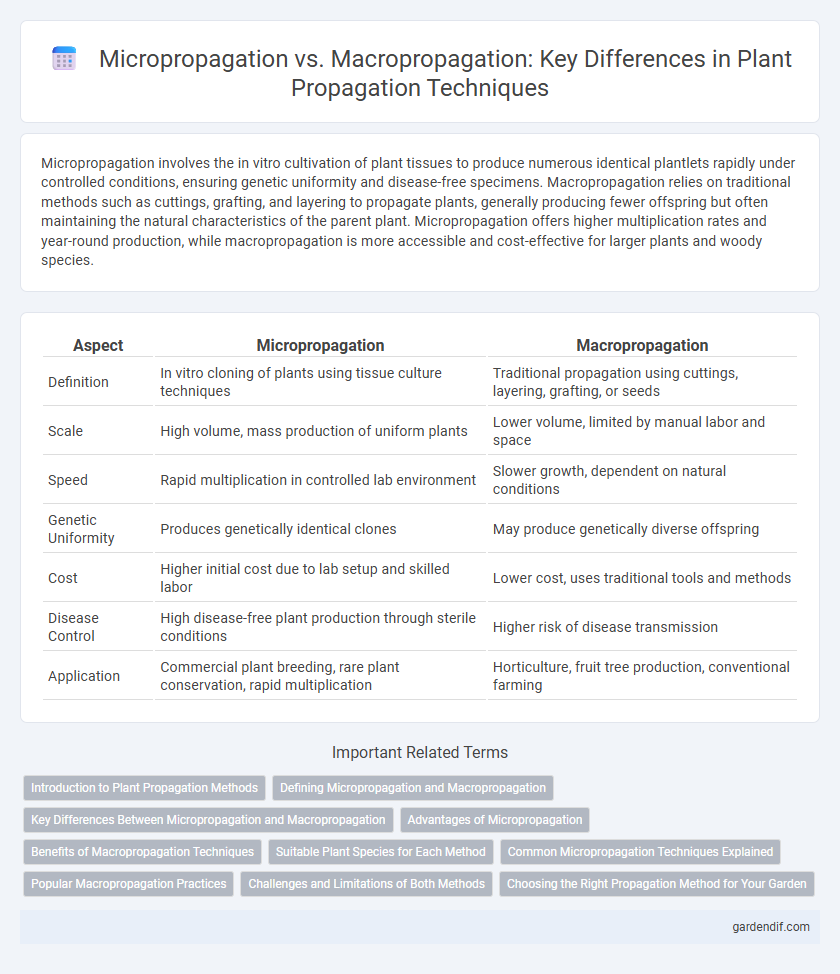
Micropropagation vs Macropropagation Illustration
Micropropagation involves the in vitro cultivation of plant tissues to produce numerous identical plantlets rapidly under controlled conditions, ensuring genetic uniformity and disease-free specimens. Macropropagation relies on traditional methods such as cuttings, grafting, and layering to propagate plants, generally producing fewer offspring but often maintaining the natural characteristics of the parent plant. Micropropagation offers higher multiplication rates and year-round production, while macropropagation is more accessible and cost-effective for larger plants and woody species.
Table of Comparison
| Aspect | Micropropagation | Macropropagation |
|---|---|---|
| Definition | In vitro cloning of plants using tissue culture techniques | Traditional propagation using cuttings, layering, grafting, or seeds |
| Scale | High volume, mass production of uniform plants | Lower volume, limited by manual labor and space |
| Speed | Rapid multiplication in controlled lab environment | Slower growth, dependent on natural conditions |
| Genetic Uniformity | Produces genetically identical clones | May produce genetically diverse offspring |
| Cost | Higher initial cost due to lab setup and skilled labor | Lower cost, uses traditional tools and methods |
| Disease Control | High disease-free plant production through sterile conditions | Higher risk of disease transmission |
| Application | Commercial plant breeding, rare plant conservation, rapid multiplication | Horticulture, fruit tree production, conventional farming |
Introduction to Plant Propagation Methods
Micropropagation leverages tissue culture techniques to produce numerous genetically uniform plants rapidly under controlled laboratory conditions, enhancing disease-free and high-quality plant production. Macropropagation involves traditional methods like cuttings, grafting, layering, or division, relying on natural plant parts to generate new individuals with varying genetic traits. The choice between micropropagation and macropropagation hinges on factors such as species, scalability, cost, and desired uniformity in propagation outcomes.
Defining Micropropagation and Macropropagation
Micropropagation is a tissue culture technique that produces large numbers of genetically identical plants from a small piece of plant tissue under sterile conditions. Macropropagation involves traditional methods such as cuttings, grafting, and layering to propagate plants using whole organs or parts of the plant. Both techniques are essential for plant cloning, but micropropagation offers faster multiplication rates and better control over genetic uniformity.
Key Differences Between Micropropagation and Macropropagation
Micropropagation uses tissue culture techniques to rapidly produce large quantities of genetically identical plants under sterile laboratory conditions, while macropropagation relies on traditional methods such as cuttings, grafting, and layering conducted in natural or greenhouse environments. Micropropagation offers faster multiplication rates and disease-free propagation compared to macropropagation, which has slower reproduction speed but is often more cost-effective for large plants. The two methods differ significantly in scale, technical requirements, and applications in agriculture and horticulture.
Advantages of Micropropagation
Micropropagation offers rapid multiplication of plants with uniform genetic traits, ensuring high-quality and disease-free specimens. This method enables mass production of rare or endangered species in a controlled environment, reducing dependence on seed availability and seasonal variations. Enhanced pathogen control, increased multiplication rates, and space-efficient facilities make micropropagation highly advantageous over traditional macropropagation techniques.
Benefits of Macropropagation Techniques
Macropropagation techniques offer significant benefits by enabling the rapid production of genetically identical plants through methods such as cuttings, grafting, and layering. These techniques improve plant vigor and stress resistance by maintaining mature tissue characteristics, leading to higher survival rates and quicker establishment in the field. Compared to micropropagation, macropropagation is cost-effective and requires less specialized equipment, making it accessible for large-scale commercial plant production.
Suitable Plant Species for Each Method
Micropropagation best suits plants that are difficult to propagate sexually or have slow seed germination, such as orchids, bananas, and certain woody plants. Macropropagation is ideal for species that readily root from stem cuttings or layering, including roses, grapes, and many fruit trees. Selecting propagation methods depends largely on plant species' biological characteristics and commercial propagation efficiency.
Common Micropropagation Techniques Explained
Micropropagation techniques such as shoot tip culture, node culture, and somatic embryogenesis enable rapid clonal propagation of plants under sterile, controlled conditions, ensuring uniformity and disease-free production. These methods utilize nutrient-rich media and precise hormone combinations to stimulate cell division and differentiation at the cellular level, unlike macropropagation which relies on conventional cuttings or layering. Micropropagation supports large-scale multiplication for horticultural, agricultural, and forestry applications, offering higher propagation rates and genetic fidelity.
Popular Macropropagation Practices
Popular macropropagation practices include grafting, layering, and cuttings, which are widely used for cloning mature plants with desirable traits. These methods ensure genetic uniformity and faster maturation compared to micropropagation techniques, which rely on tissue culture for mass production. Macropropagation is preferred for its lower cost and practicality in large-scale nursery operations.
Challenges and Limitations of Both Methods
Micropropagation faces challenges such as high initial setup costs, risk of contamination, and the requirement for skilled labor, limiting its accessibility for small-scale growers. Macropropagation is constrained by slower propagation rates, greater space requirements, and vulnerability to environmental fluctuations affecting plant cuttings or grafts. Both methods encounter genetic variability concerns, with micropropagation risking somaclonal variation and macropropagation dependent on the health and vigor of source plants.
Choosing the Right Propagation Method for Your Garden
Micropropagation leverages tissue culture techniques to rapidly produce disease-free, genetically uniform plants, making it ideal for commercial nurseries and rare species conservation. Macropropagation involves traditional methods like cuttings, layering, and grafting, offering simplicity and cost-effectiveness for home gardeners and common plant varieties. Selecting the right propagation method depends on factors such as plant species, desired quantity, resources, and growth time, ensuring efficient and successful garden development.
Micropropagation vs Macropropagation Infographic

 gardendif.com
gardendif.com